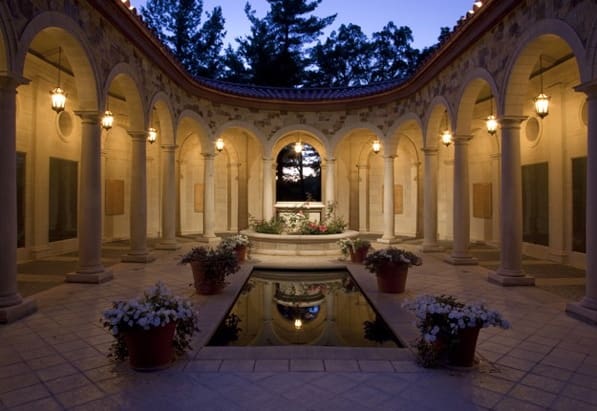Editor’s note: This post was originally published on 12/12/2013.
This month, in honor of Our Lady of Guadalupe, we’re doing a three-part post on the story of Our Lady of Guadalupe, and the two shrines in her honor.
See part I here and part II here. I encourage you to read more about it in Mary of the Americas, A Handbook on Guadalupe, The Story of Our Lady of Guadalupe Empress of the Americas, or Our Lady of Guadalupe and the Conquest of Darkness.
The Shrines of Our Lady of Guadalupe in the Americas
Mexico City
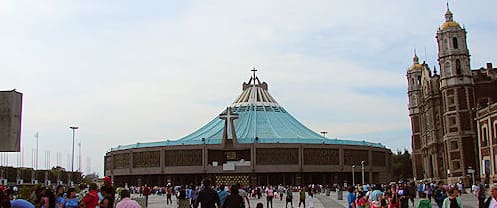 Shortly after Juan Diego–and Our Lady’s image–convinced the Bishop that the Blessed Mother’s apparitions were real, he started building her a chapel. From 1531 until today, the shrine of Our Lady in Mexico City has grown from that small chapel on a hill to an entire plaza filled with a Basilica and other buildings in her honor, known collectively as La Villa de Guadalupe. This video provides a lovely look.
Shortly after Juan Diego–and Our Lady’s image–convinced the Bishop that the Blessed Mother’s apparitions were real, he started building her a chapel. From 1531 until today, the shrine of Our Lady in Mexico City has grown from that small chapel on a hill to an entire plaza filled with a Basilica and other buildings in her honor, known collectively as La Villa de Guadalupe. This video provides a lovely look.
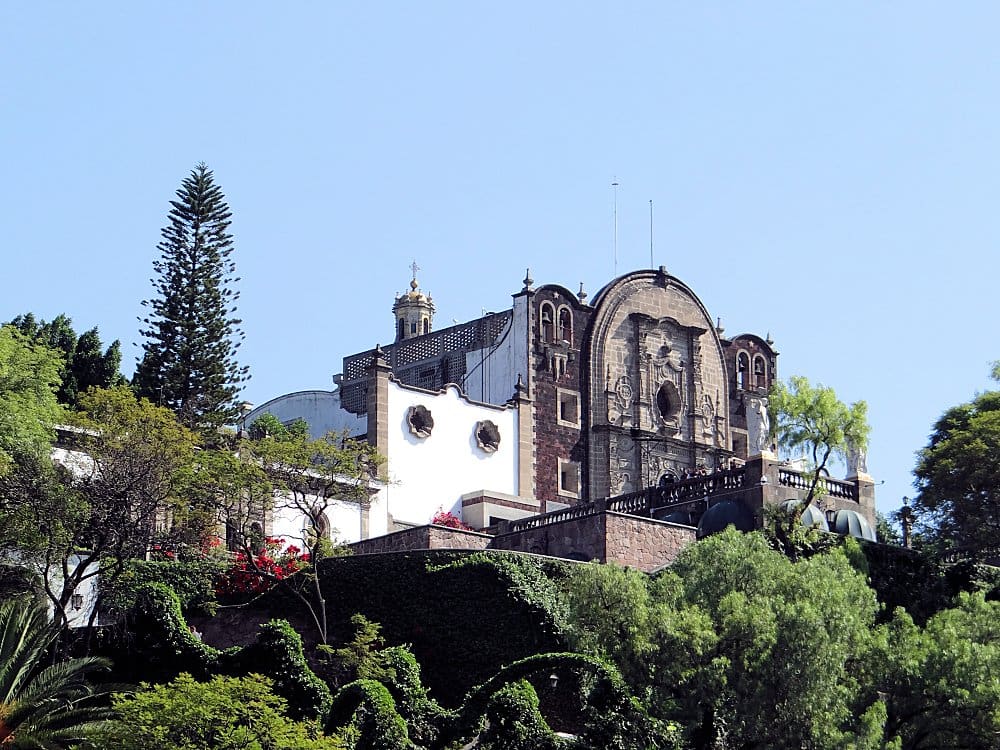 The Antigua Parroquia de Indios (Ancient Parish of the Indians), built between 1531-32, was where Juan’s tilma was first kept for public veneration and where he lived until his death. The current structure dates to 1649 and houses St. Juan’s mortal remains. The Capilla del Pocito (Chapel of the Little Well) was built between 1777-1791 over a spring that is believed to have miraculously appeared after the apparition. The Capilla del Cerrito (Chapel of the Little Hill) was built atop Tepeyac Hill, where Juan first met Mary and where he picked the Castilian roses.
The Antigua Parroquia de Indios (Ancient Parish of the Indians), built between 1531-32, was where Juan’s tilma was first kept for public veneration and where he lived until his death. The current structure dates to 1649 and houses St. Juan’s mortal remains. The Capilla del Pocito (Chapel of the Little Well) was built between 1777-1791 over a spring that is believed to have miraculously appeared after the apparition. The Capilla del Cerrito (Chapel of the Little Hill) was built atop Tepeyac Hill, where Juan first met Mary and where he picked the Castilian roses.
The ancient basilica, El Templo Exiatorio a Cristo Rey (Expiatory Temple to Christ the King), was built from 1685-1709. Its dome is covered with yellow talavera clay tiles and it sits atop a Baroque church made of red volcanic rock and sandstone. Octagonal towers topped with smaller domes are at each corner. Juan’s tilma was venerated here until 1976 when it was moved to the new basilica. Over the years, because of nearby construction and Mexico City’s unstable ground (it was built on a lake), the basilica suffered serious structural damage and was closed from 1974 until 2000.
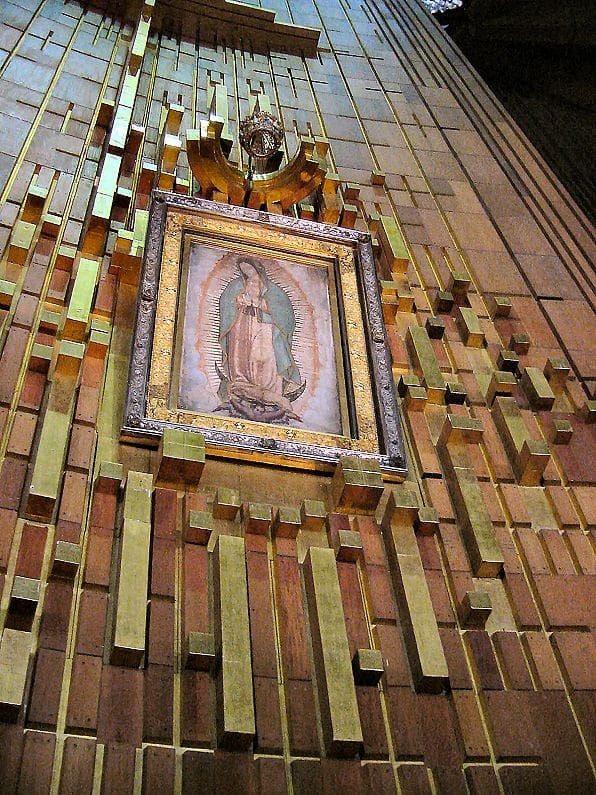 On December 12, 1976, the Basilica and Shrine of Our Lady of Guadalupe was consecrated. Built in a circular plan out of reinforced concrete and copper sheets that have since oxidized, it was designed to allow an unobstructed view of Juan’s tilma, which is above and behind the sanctuary. A conveyor belt slowly transports pilgrims behind the sanctuary for a closer look. Millions visit every year, especially on December 12th, the Feast of Nuestra Señora de Guadalupe, during which mariachis and proud Mexicans serenade La Morenita (the little brown one) with Las Mañanitas, Mexico’s version of Happy Birthday, Catholic style.
On December 12, 1976, the Basilica and Shrine of Our Lady of Guadalupe was consecrated. Built in a circular plan out of reinforced concrete and copper sheets that have since oxidized, it was designed to allow an unobstructed view of Juan’s tilma, which is above and behind the sanctuary. A conveyor belt slowly transports pilgrims behind the sanctuary for a closer look. Millions visit every year, especially on December 12th, the Feast of Nuestra Señora de Guadalupe, during which mariachis and proud Mexicans serenade La Morenita (the little brown one) with Las Mañanitas, Mexico’s version of Happy Birthday, Catholic style.
La Crosse, Wisconsin
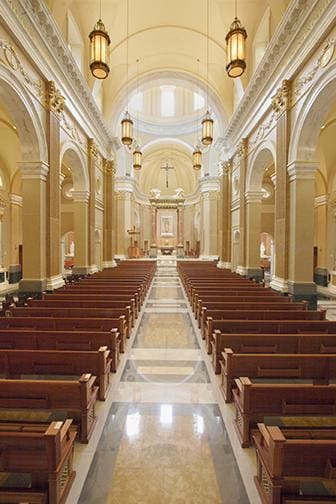 In the United States, we are blessed with the Shrine of Our Lady of Guadalupe in La Crosse, Wisconsin. Built between 2001 and 2008, this amazing shrine not only includes a pilgrim center, rosary walk, stations of the cross, friary, votive candle chapel, and memorial to the unborn, but also one of the most spectacular churches built in the last twenty (maybe even fifty) years. The church was designed in the classical style by Duncan Stroik, professor of architecture at Notre Dame and founder of The Institute for Sacred Architecture. The interior was decorated by a variety of artists; the principal artist was Anthony Visco, whose art we featured in our episode on Philadelphia’s National Shrine of St. Rita of Cascia.
In the United States, we are blessed with the Shrine of Our Lady of Guadalupe in La Crosse, Wisconsin. Built between 2001 and 2008, this amazing shrine not only includes a pilgrim center, rosary walk, stations of the cross, friary, votive candle chapel, and memorial to the unborn, but also one of the most spectacular churches built in the last twenty (maybe even fifty) years. The church was designed in the classical style by Duncan Stroik, professor of architecture at Notre Dame and founder of The Institute for Sacred Architecture. The interior was decorated by a variety of artists; the principal artist was Anthony Visco, whose art we featured in our episode on Philadelphia’s National Shrine of St. Rita of Cascia.
 High on a bluff and surrounded by trees, the church’s exterior walls are simple and pretty. Inside the narthex, Anthony Visco’s fresco, “Visions of Guadalupe”, illustrates Our Lady’s meetings with Juan, from Tepeyac Hill to the healing of his uncle. Past the narthex, the walls, pilasters, and arches are a warm beige. Chubby cherubim peek out from flowery Corinthian capitals, and symbols of our Blessed Mother are everywhere–from the medals between the
High on a bluff and surrounded by trees, the church’s exterior walls are simple and pretty. Inside the narthex, Anthony Visco’s fresco, “Visions of Guadalupe”, illustrates Our Lady’s meetings with Juan, from Tepeyac Hill to the healing of his uncle. Past the narthex, the walls, pilasters, and arches are a warm beige. Chubby cherubim peek out from flowery Corinthian capitals, and symbols of our Blessed Mother are everywhere–from the medals between the 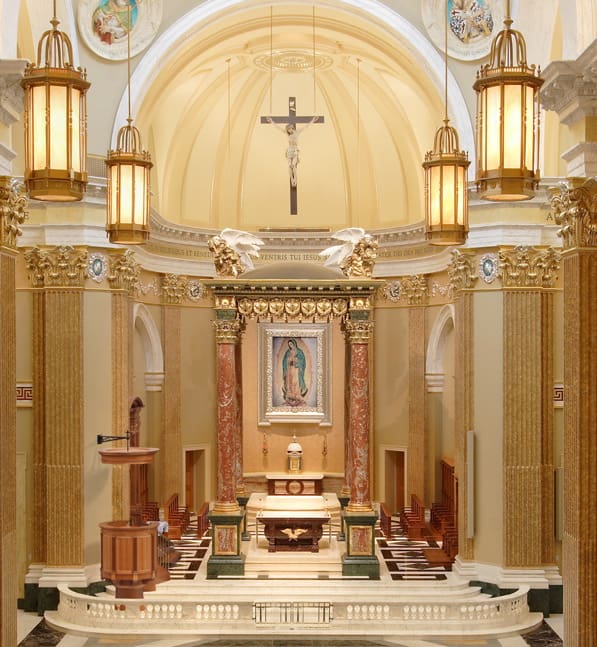 capitals to the stained glass windows. Names attributed to Mary from the Litany of Loreto are inscribed above. Above and behind the sanctuary is a nine-foot mosaic of Juan’s tilma, framed in silver. Atop the red marble baldacchino, four life-sized angels bear wheat and grapes, symbolizing the Eucharist. The teal dome mimics the design of Our Lady’s mantle, and features the golden constellations of December 12, 1531. Shrines of the Divine Mercy and St. Faustina, St. Maria Goretti, St. Peregrine, St. Gianna Beretta Molla, Blessed Miguel Pro, and St. Thérèse of Lisieux line the aisles.
capitals to the stained glass windows. Names attributed to Mary from the Litany of Loreto are inscribed above. Above and behind the sanctuary is a nine-foot mosaic of Juan’s tilma, framed in silver. Atop the red marble baldacchino, four life-sized angels bear wheat and grapes, symbolizing the Eucharist. The teal dome mimics the design of Our Lady’s mantle, and features the golden constellations of December 12, 1531. Shrines of the Divine Mercy and St. Faustina, St. Maria Goretti, St. Peregrine, St. Gianna Beretta Molla, Blessed Miguel Pro, and St. Thérèse of Lisieux line the aisles.
I could go on about this shrine forever, and I haven’t even seen it. Just a peek at their website and many videos makes me want to plan a trip, and I hope it does the same for you. When you go, please pray for the people of Mexico. I’m sure Our Lady hasn’t stopped hearing their cries.
¡Que viva la Virgen de Guadalupe!
++++++++++++++++++++++++++++++++++++++++++++++++++++++++++++++++++++++++++++++
Additional resources may be found here:
- Secrets of the Image: http://www.secretsoftheimage.org/en/index.html
- Truths of the Image: http://www.truthsoftheimage.org/en/index.html
- A British documentary on Our Lady: https://www.youtube.com/watch?v=uzqFg-XYWHI
Special thanks to Sister M. Ancilla, FSGM, MA, of the Shrine of Our Lady of Guadalupe for her invaluable insight and editorial assistance.
Art: Photos of The Shrine of Our Lady of Guadalupe in Mexico City used with permission of http://www.delange.org/Guadalupe2/Guadalupe2.htm and http://www.delange.org/Guadalupe/Guadalupe.htm; “Las Mañanitas” Diana von Glahn; Pictures of the Shrine of Our Lady of Guadalupe in La Crosse (c) Shrine of Our Lady of Guadalupe, La Crosse, Wisconsin, used with permission.
++++++++++++++++++++++++++++++++++++++++++++++++++++++++++++++++++++++++++++++
Editor’s Note: There is also a national shrine of Our Lady of Guadalupe in the Philippines. Our Lady of Guadalupe was declared “Heavenly Patroness of the Philippines” on July 16, 1935 by Pope Pius XI.




